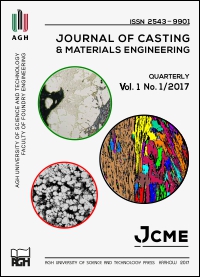Etching Method to Create Random Speckle Pattern on Semi-Solid Cast A356 Aluminium for DIC in-situ strain measurement
DOI:
https://doi.org/10.7494/jcme.2017.1.1.33Abstract
Aluminum semi-solid casting is constantly evolving, as it offers a combination of reduced shrinkage porosity and gas
entrapment defects together with high productivity and an extended die-life. The relationship between the microstructure
and stress-strain behavior is not well-understood due to its non-conventional microstructure. In-situ tensile testing,
combined with optical microscope and Digital Image Correlation (DIC), has been used for local strain distribution
measuements in cast irons. The critical capability was an etching technique to generate a micro-scale random speckle
pattern with a sufficiently high speckle density to enable the sufficient spatial resolution of displacement and strain.
The current paper focuses on the development of a pit etching procedure for the semi-solid cast A356 aluminum alloy to
study local strain accommodation on the microstructure during tensile loading. The critical challenge of this procedure
was the generation of homogeneously distributed pits on both the primary aluminum and eutectic regions. Therefore,
a heated solution used for wet-etch aluminum in microfabrication was modified as well as a process adapted to generate
pits with suitable characteristics. In-situ tensile tests were performed attached to an optical microscope to record
the microstructure and displacements during loading. DIC software was used for analysis. The procedure was validated
through a comparison between the resulting Young´s moduls using standard tensile testing and the DIC process
on the speckle pattern generated. A good fit between the two methods for Young´s modulus was found. The spatial resolution
obtained was, however, not sufficient to fully resolve the strain gradients in the microstructure, but it did reveal
large strain variations in the microstructure.
Downloads
References
Campillo M., Baile M.T., Menargues S. & Forn A. (2010). The effect of injection conditions on the structural integrity of the components produced by semi-solid Rheocasting. International Journal Material Forming, 3, no. suppl. 1, 751–754.
Menargues S., Martín E., Baile M.T. & Picas J.A. (2015). New short T6 heat treatments for aluminium silicon alloys obtained by semisolid forming. Materials Science and Engineering A, 621, 236–242.
Kasvayee K.A., Elmquist L., Jarfors A.E.W. & Ghassemali E. (2014). Development of a pattern making method for strain Measurement on microstructural level in ferritic cast iron. Processing and Fabrication of Advanced Materials, 23, 1121–1135.
Schreier H., Orteu J.J. & Sutton M.A. (2009). Image correlation for shape, motion and deformation measurements: Basic concepts, theory and applications, Springer US.
Kasvayee K.A., Ghassemali E. & Jarfors A.E.W. (2015). Microcrack initiation in high-silicon cast iron during tension loading. In The Minerals, Metals & Materials Society (Ed.) TMS2015: 144th Annual Meeting & Exhibition, Supplemental proceedings, Springer International Publishing 947–953.
Kasvayee K.A., Ghassemali E., Salomonsson K. & Jarfors A.E.W. (2015). Microstructural strain localization and crack evolution in ductile iron. JTH research report.
A356.0 aluminium casting alloy (7Si-0.3Mg) (2012). Hadleigh Castings, 3–4.
Kaufman J.G. & Rooy E.L. (2004). Aluminum Alloy Castings: Properties, Processes, and Applications. ASM International.
Linder J. (2012). Alcoholate corrosion of aluminium in ethanol blends – the effects of water content, surface treatments, temperature, time and pressure. Master thesis. KTH Royal Institute of Technology, Stockholm, Sweden.
Ghali E. (2000). Aluminum and aluminum alloys. In R. Winston Revie (Ed.) Uhlig’s Corrosion Handbook, Second Edition, New York: John Wiley & Sons, Inc. 677–690.
Lee J., Kim J., Kim J., Lee J., Chung H. & Tak Y. (2009). Effects of pretreatment on the aluminium etch pit formation. Corrosion Science, 51(7), 1501–1505.
Beck T.R. (1988) Size distribution of etch pits in aluminum. Electrochimica. Acta, 33(10), 1321–1327.
Bellenger F. (2002). Etude et contrôle de la corrosion feuilletante des alliages d’aluminium 2024 et 7449 par bruit électrochimique et émission acoustique. Analyse microstructurale et caractérisation de l’endommagement. Lyon: L’Institut National des Sciences Appliquées de Lyon.
Granath O., Wessén M. & Cao H. (2008) Determining effect of slurry process parameters on semisolid A356 alloy microstructures produced by RheoMetal process. International Journal of Cast Metals Research, 21(5), 349–356.
Wolf S. & Tauber R.N. (1986). Silicon Processing for the VLSI Era, Volume 1 – Process Technology. Latticce Press, 531–535.
Reu P. (2014). Speckles and their relationship to the digital camera. Experimental Technique, 38(4), 1–2.
MatchID 2D. Retrieved from: http://matchidmbc.be/2D.html (accesed 15.12.2017).
Arrabal R., Mingo B., Pardo A., Mohedano M., Matykina E. & Rodríguez I. (2013). Pitting corrosion of rheocast A356 aluminium alloy in 3.5wt.% NaCl solution. Corrosion Science, 73, 342–355.
Lecompte D., Smits A., Bossuyt S., Sol H., Vantomme J., Van Hemelrijck D. & Habraken A.M. (2006) Quality assessment of speckle patterns for digital image correlation. Optics and Lasers in Engineering, 44(11), 1132–1145.
Hung P-C. & Voloshin A.S. (2003). In-plane strain measurement by digital image correlation. Journal of the Brazilian Society of Mechanical Sciences and Engineering, 25(3), 215–221.
Downloads
Published
Issue
Section
How to Cite
Accepted 2017-01-17
Published 2017-03-17


